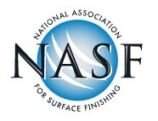Corrosion & Accelerated Corrosion Tests
Recommended Time & Experience: Some experience with accelerated corrosion testing and interpretation of results in a lab environment. For those a few years away from taking any chemistry courses, the Chemistry Refresher course offered by NASF Foundation is highly recommended, but not required as a pre-requisite.
Description: This course provides an in-depth understanding of the accelerated corrosion testing commonly used in the industry with an emphasis on salt-spray cabinet operations, corrosion mechanisms, and corrosion testing.
Secondary Elective: Master Surface Finishers (MSF) designation.
Designed For: But not limited to: Quality Control and Lab personnel responsible for the operation of corrosion chambers.
Course Content Level: Intermediate to Advanced (200 to 300 Level)
Approx Hours to Complete: 10 Hours
Learning Objectives: Those completing this course and/or earning a certificate in Corrasion & Salt Spray are able to demonstrate:
- The proper selection and maintenance the proper chemistry of a salt-spray corrosion chamber and preparation of samples for testing.
- Accurate reading and recording of results for different finishes and substrates.
- Clear understanding of achieving customer requirements, specification requirements and interpretation of standards including ASTM B-117.
- Overview of alternate accelerated corrosion tests including CASS, Humidity Chambers, Corrodkote, Acetic Acid, and Kesternich tests.
Course Description:
- Corrosion Principles, Tests & Design for Corrosion Protection Part 1
This lesson begins by identifying the most common mechanisms for the onset of corrosion. The lesson that describes the galvanic/Electromotive Force Series of metals and how they apply to corrosion of plated parts. The concept of galvanic corrosion cells is further developed to include stressed metal corrosion mechanisms. Students are taught how these mechanisms are incorporated into accelerated corrosion test chambers. How various coatings may or may not afford sacrificial corrosion protection is a main focus of this lesson.
- Corrosion Principles, Tests & Design for Corrosion Protection Part 2
In part 2 of this lesson, differential oxygen concentration corrosion, fretting corrosion, and stress corrosion cracking are covered. A secondary focus of the lesson is the design factors that go into a part that successfully resists (or fails) corrosion tests. The lesson also covered ASTM B456 requirements for electroplated copper-nickel chromium deposits. - Equipment for Salt Spray Testing
This lesson provides equipment guidelines for conducting accelerated corrosion testing with a focus on the salt spray test. Each major component from the cabinet to the spray nozzle is described in detail along with the differences in design between various suppliers.
- Salt Spray Cabinet Maintenance & Operation
This lesson provides a detailed look at operational conditions that can affect test results. Special attention is given to monitoring chamber conditions and recordkeeping.
- Preparing, Exposing & Evaluating Parts
This lesson explores the most often mentioned question regarding salt spray testing; “how should parts be masked, exposed, and evaluated?” Numerous examples are provided. Students are also taught how to handle parts before and after testing, and how to recognize surface corrosion.
- Alternate Accelerated Corrosion Tests
This lesson provides basic information on other accelerated corrosion tests, including CASS, Corrodkote, Acetic Acid, and Kesternich tests, with a special focus on the increasingly popular CASS (Copper Accelerated Salt Spray) test. An important part of this lesson is how to conduct a corrosivity test on a CASS test chamber. Equipment and operational differences between the alternate and the sea salt spray test are also given.
- Salt Spray Failures
The salt spray test may indicate a coating failure, even when the coating has been properly applies. This is most commonly found on aluminum test panels that have been conversion coated and on boric sulfuric anodized aluminum test panels processed per aerospace specifications. The lesson explores the potential cause of failures including problems in conducting the test, problems with the test panels, and problems on the processing lines. The lesson focuses heavily on operational conditions that can easily be overlooked– wrong exposure angle, for example.
